
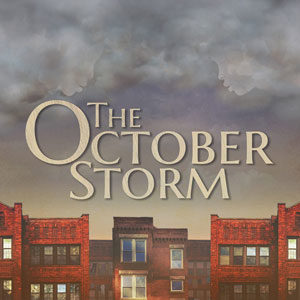 [rating=4]“The October Storm” by Joshua Allen is a story about the fine line between freedom, rebellion, and the ability and desire to cope with life’s uncertainties. Directed by Malkia Stampley, it tells an authentic but sad tale having to do with an African American family living on Chicago’s South Side in the year 1960. This is an interesting sociological vignette and very much a “slice of life” as we see the effects of racial segregation as it melds with the overall culture of that time period. The best part about this show is that the action unfolds in a very easy-going manner as if the audience were a fly on the wall. But what this means is that there are many moments when the story is slow and sluggish; and initially, it seems a bit choppy and haphazard. Yet as the characters draw together during the second act, that is when the show makes its greatest impact. It is at the close of the performance (and especially once it is over—and on reflection) that one can fully appreciate the depth of detail and caring that went into the script and how well each of the characters is personified.
[rating=4]“The October Storm” by Joshua Allen is a story about the fine line between freedom, rebellion, and the ability and desire to cope with life’s uncertainties. Directed by Malkia Stampley, it tells an authentic but sad tale having to do with an African American family living on Chicago’s South Side in the year 1960. This is an interesting sociological vignette and very much a “slice of life” as we see the effects of racial segregation as it melds with the overall culture of that time period. The best part about this show is that the action unfolds in a very easy-going manner as if the audience were a fly on the wall. But what this means is that there are many moments when the story is slow and sluggish; and initially, it seems a bit choppy and haphazard. Yet as the characters draw together during the second act, that is when the show makes its greatest impact. It is at the close of the performance (and especially once it is over—and on reflection) that one can fully appreciate the depth of detail and caring that went into the script and how well each of the characters is personified.
Mrs. Elkins (Shariba Rivers) has taken care of her granddaughter Gloria (Jaeda LaVonne) since birth, when Gloria’s mother abandoned her to live in Hollywood, California. Gloria has always lived with her grandmother, who has constantly demonstrated her caring by spending a good amount of money on her, including paying for her Catholic school education, a sign of higher status within the African American community (as indicated by Gloria’s plaid skirt). We learn that Gloria and her schoolmate/boyfriend Crutch (Brandon J. Sapp) (who always wears his school tie) travel together by trolley every day to their racially integrated school in a different neighborhood—with the implication that due to racial segregation at the time, blacks were not able to travel to and from that part of the city after dark. Furthermore, we see Mrs. Elkins put a hair straightening flat iron into Gloria’s hair. She even comments that she wants her granddaughter’s hairstyle to be not so much different from that of the white girls at the school. This was 1960, when white and European hairstyles predominated before the “Black is Beautiful” movement.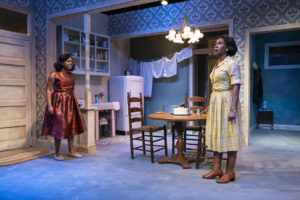
At the same time that Mrs. Elkins takes care of her granddaughter (and currently holds down a job that is only talked about), she acts on behalf of the owner of their three-flat apartment building. While she and Gloria live in the basement apartment, Lucille (Felisha D. McNeal, who is always so refreshing whenever she takes the stage) resides on the first floor immediately above. The second-floor apartment becomes home to Louis (in a wonderful performance by Nathaniel Andrew). He is a Korean war veteran, originally from Alabama and arrives in Chicago looking for work. Mrs. Elkins secretly gets him a job, so that he could afford the rent. But Louis, as it turns out, suffers from PTSD: What initially seems like a subplot in the first act grows into a more substantial thread in the second. My guest caught this nuance before I did, and so I feel that this plot point should have been made more deliberate earlier on.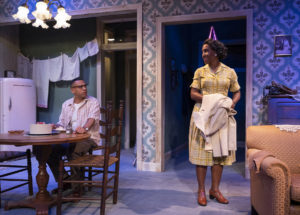
Now at the age of 16, Gloria feels that she is a burgeoning adult and (perhaps as a form of teenage rebellion) doesn’t want to follow her grandmother’s rules anymore. She feels that the rules are too strict and that she is already very much an adult. Above all, she wants to find out more about the mother who has ostensibly abandoned her. Did her mother ever really care about her, or not? Or is her grandmother hiding some important set of truths from her? Just as importantly, Gloria is tired of school, prefers to show her maturity by smoking cigarettes, wants to get into a sexual relationship, and wants to leave her grandmother’s apartment. It is this immaturity (which she mistakes for being mature) which leads her to forsake what could be a tried-and-true path for success. In this respect, this is a coming-of-age story, but it goes one step further. During the course of the play, when Gloria puts away “childish things”, she shifts her attention away from Crutch and decides to chase Louis, who is, of course, much older than she is. Although he could be considered a “bad boy” in matters of sexual propriety, he is a good person by nature. Through his lens, we get a glimpse into racism and colorism in relation to how he is treated on the job. Louis’s anger with his peers at work (in combination with the thunderclaps from an October storm) trigger his underlying PTSD, and soon life becomes too much for him.
Scenic designer Sotirios Livaditis has created a very genuine-looking set where the Elkins family resides. I liked the room arrangement and the green and pink wallpaper, whose colors are carried forth in Bren Coomb’s prop design. (As an aside, the set featured the exact same coffee table that my grandmother owned in 1960—and I’d forgotten about it over the years!) Jared Gooding’s lighting design could not have been better, especially in moving us from one scene to the next. Costume designer Alexia Rutherford has created authentic vintage costumes befitting the era, and Megan E. Pirtle has done a faultless job with her wig design. Fight and intimacy director Jyreika Guest has beautifully managed the physical arguments on stage as well as the way that Louis’s drunkenness is handled. Christopher Kriz, with his original music and sound design, always excels, although I thought that the sound of thunder should have been much louder, since it is essential to triggering Louis’s PTSD. Having said that, I liked the word “storm” in the title of the show, because there is more than one stormy relationship within. But the word “October” in the title is more elusive. Other than a reference to Halloween and Mrs. Elkins’ feeling that this is the Devil’s holiday, the fact that the story takes place in October seems quite tangential. A different title, in my opinion, would have more suitable.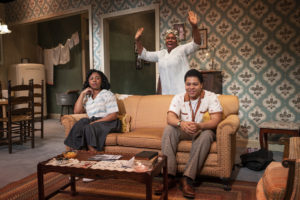
In all, this is a very American tale in that the characters want to seek their own path wherever that may lead. But at the same time, this is a very uniquely African American story. For example, while there are grandmothers in all cultures, there is a special relationship between the African American grandmother and her grandchild. In this play, Mrs. Elkins constantly wants her rapport to be better with her granddaughter, but she realizes that it is hard to compete with the idea of freedom and Gloria’s wish to be responsible only to herself. In the end, the grandmother questions her own feelings and motivations and wonders why her own daughter left her and now her granddaughter wants to leave her. Is she that terrible of a person? Now that Mrs. Elkins has raised that question, can the audience infer that her relationship with her daughter (namely, Gloria’s mother) was any different than her relationship with Gloria today? Any answer would be mere speculation.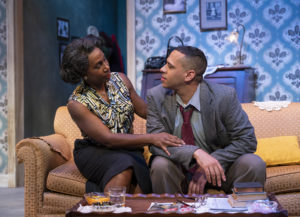
While I was watching this presentation, I began to wonder how much does one need to know about the history and culture of the African American community in Chicago to fully appreciate the story. For example, it’s a minor detail, but if you lived through the year 1960 on the South Side (which I did), then one gets the symbolism of traveling to the 79th Street Woolworth’s store, which is briefly mentioned. This was a local branch of the nationwide chain, that was once located in an all-white neighborhood but, due to neighborhood succession, found itself in 1960 within a mostly black area of the city. My general point is this: If this show is meant to be a teaching moment, then some of the dialogue ought to contain a few memorable quotations and explanations (in addition to everyday parlance) so that audience members of all races and backgrounds can be better clued into the underlying situation of this era and those who were living through it.
“The October Storm” is playing through June 25, 2023, at the Raven Theatre (Johnson Stage), 6157 N. Clark Street, Chicago.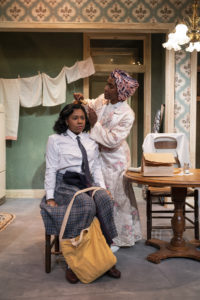
Single tickets – $40
Student/Military – $15 (with proof of enrollment/service)
Industry Night – $15 (Thursdays only, with proof of industry
Special Group Rates are available for parties of 6 or more.
Performance schedule:
Thursdays, Fridays, and Saturdays – 7:30 p.m.
Sundays – 3:00 p.m.
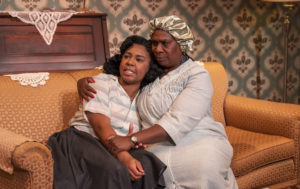 SPECIAL DATES:
SPECIAL DATES:
Neighborhood Night: Friday, June 2nd. See: https://www.raventheatre.com/neighborhood/.
Closed Captioning: Sunday, June 4th
Touch Tour*: Sunday, June 11th @ 1:30 p.m., 3:00 p.m. matinee
Black Out Night: Thursday, June 15th. See: https://www.raventheatre.com/blackout/.
Post-Show Talkback: Sunday, June 18th
*Please call to reserve for the Closed Captioning and Touch Tour performances.
For more information or to purchase tickets, visit https://www.raventheatre.com/stage/tos/ or call 773-338-2177 or email info@raventheatre.com.
For general information and to learn about the Raven Theatre’s other offerings, go to: https://www.raventheatre.com/.
To see what others are saying, visit www.theatreinchicago.com, go to Review Round-Up and click at “The October Storm”.






More Stories
“Henry Johnson”
“Scary Town” reviewed by Frank Meccia
“Translations”